
How many different types of protons are present in each compound?
a.
 h.
h.
b.
 i.
i.
c.
d.
![]()
(a)
Interpretation: The different types of protons present in given compound are to be predicted.
Concept introduction: Spectroscopy method is used to identify the structure of the molecule. It is based on the interactions between matter and electromagnetic radiations. Proton NMR spectroscopy identifies the number of hydrogen atoms present in a molecule and the nature of the functional group. The value of chemical peaks depends upon the chemical environment around the hydrogen atom.
Answer to Problem 14.35P
In the given compound, two different types of protons are present.
Explanation of Solution
In the given compound
In the given compound, two different types of protons are present.
(b)
Interpretation: The different types of protons present in given compound are to be predicted.
Concept introduction: Spectroscopy method is used to identify the structure of the molecule. It is based on the interactions between matter and electromagnetic radiations. Proton NMR spectroscopy identifies the number of hydrogen atoms present in a molecule and the nature of the functional group. The value of chemical peaks depends upon the chemical environment around the hydrogen atom.
Answer to Problem 14.35P
In the given compound, two different types of protons are present.
Explanation of Solution
The given compound contains only one type of proton as shown below.
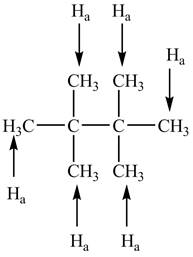
Figure 1
Two carbon atomsare bonded to three other carbon atoms on which three hydrogen atoms are present. Six methyl groups give singlet due to absence of hydrogen atom on the neighboring carbon atom. Thus, only one type of proton is present.
In the given compound, one type of protons is present.
(c)
Interpretation: The different types of protons present in given compound are to be predicted.
Concept introduction: Spectroscopy method is used to identify the structure of the molecule. It is based on the interactions between matter and electromagnetic radiations. Proton NMR spectroscopy identifies the number of hydrogen atoms present in a molecule and the nature of the functional group. The value of chemical peaks depends upon the chemical environment around the hydrogen atom.
Answer to Problem 14.35P
In the given compound, seven different types of protons are present.
Explanation of Solution
The given compound contains seven different types of protons each labeled as

Figure 2
Each proton will give different chemical shift value in NMR spectroscopy.
In the given compound, seven different types of protons are present.
(d)
Interpretation: The different types of protons present in given compound are to be predicted.
Concept introduction: Spectroscopy method is used to identify the structure of the molecule. It is based on the interactions between matter and electromagnetic radiations. Proton NMR spectroscopy identifies the number of hydrogen atoms present in a molecule and the nature of the functional group. The value of chemical peaks depends upon the chemical environment around the hydrogen atom.
Answer to Problem 14.35P
In the given compound, three different types of protons are present.
Explanation of Solution
The given compound contains four different types of protons each labeled as
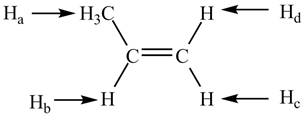
Figure 3
Since
In the given compound, four different types of protons are present.
(e)
Interpretation: The different types of protons present in given compound are to be predicDted.
Concept introduction: Spectroscopy method is used to identify the structure of the molecule. It is based on the interactions between matter and electromagnetic radiations. Proton NMR spectroscopy identifies the number of hydrogen atoms present in a molecule and the nature of the functional group. The value of chemical peaks depends upon the chemical environment around the hydrogen atom.
Answer to Problem 14.35P
In the given compound, five differenttypes of protons are present.
Explanation of Solution
The given compound contains five different types of protons each labeled as

Figure 4
Each proton will give different chemical shift value in NMR spectroscopy.
In the given compound, five different types of protons are present.
(f)
Interpretation: The different types of protons present in given compound are to be predicted.
Concept introduction: Spectroscopy method is used to identify the structure of the molecule. It is based on the interactions between matter and electromagnetic radiations. Proton NMR spectroscopy identifies the number of hydrogen atoms present in a molecule and the nature of the functional group. The value of chemical peaks depends upon the chemical environment around the hydrogen atom.
Answer to Problem 14.35P
In the given compound, three different types of protons are present.
Explanation of Solution
The given compound contains three different types of protons each labeled as
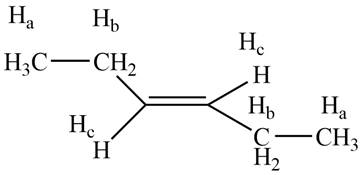
Figure 5
Each proton will give different chemical shift value in NMR spectroscopy.
In the given compound, three different types of protons are present.
(g)
Interpretation: The different types of protons present in given compound are to be predicted.
Concept introduction: Spectroscopy method is used to identify the structure of the molecule. It is based on the interactions between matter and electromagnetic radiations. Proton NMR spectroscopy identifies the number of hydrogen atoms present in a molecule and the nature of the functional group. The value of chemical peaks depends upon the chemical environment around the hydrogen atom.
Answer to Problem 14.35P
In the given compound three different types of protons are present.
Explanation of Solution
The given compound contains three different types of protons each labeled as
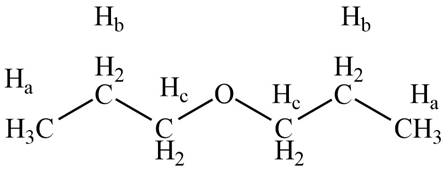
Figure 6
Each proton will give different chemical shift value in NMR spectroscopy.
In the given compound, three different types of protons are present.
(h)
Interpretation: The different types of protons present in given compound are to be predicted.
Concept introduction: Spectroscopy method is used to identify the structure of the molecule. It is based on the interactions between matter and electromagnetic radiations. Proton NMR spectroscopy identifies the number of hydrogen atoms present in a molecule and the nature of the functional group. The value of chemical peaks depends upon the chemical environment around the hydrogen atom.
Answer to Problem 14.35P
In the given compound four different types of protons are present.
Explanation of Solution
The given compound contains four different types of protons each labeled as
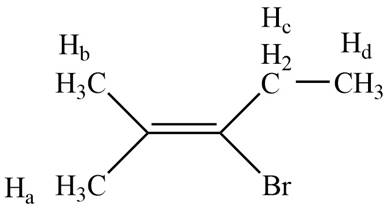
Figure 7
Each proton will give different chemical shift value in NMR spectroscopy.
In the given compound four different types of protons are present.
(i)
Interpretation: The different types of protons present in given compound are to be predicted.
Concept introduction: Spectroscopy method is used to identify the structure of the molecule. It is based on the interactions between matter and electromagnetic radiations. Proton NMR spectroscopy identifies the number of hydrogen atoms present in a molecule and the nature of the functional group. The value of chemical peaks depends upon the chemical environment around the hydrogen atom.
Answer to Problem 14.35P
In the given compound, six different types of protons are present.
Explanation of Solution
In the given compound, a chiral carbon atom is bonded to another carbon atom on which two protons and an methyl group is present. Hence, these protons are termed as diasterotropic protons. Each diasterotropic protons gives different chemical shift value.
Therefore, the given compound contains six different types of protons each labeled as

Figure 8
Each proton will give different chemical shift value in NMR spectroscopy.
In the given compound, six different types of protons are present.
(j)
Interpretation: The different types of protons present in given compound are to be predicted.
Concept introduction: Spectroscopy method is used to identify the structure of the molecule. It is based on the interactions between matter and electromagnetic radiations. Proton NMR spectroscopy identifies the number of hydrogen atoms present in a molecule and the nature of the functional group. The value of chemical peaks depends upon the chemical environment around the hydrogen atom.
Answer to Problem 14.35P
In the given compound four different types of protons are present.
Explanation of Solution
The given compound contains four different types of protons each labeled as
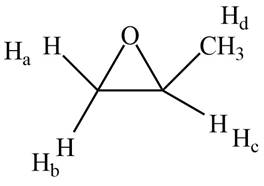
Figure 9
Each proton will give different chemical shift value in NMR spectroscopy.
In the given compound four different types of protons are present.
Want to see more full solutions like this?
Chapter 14 Solutions
Organic Chemistry-Package(Custom)
- Show your work and do something that is reasonable. It does not have to be 100% correct. Just show something that looks good or pretty good as acceptable answers. Something that looks reasonable or correct would be sufficient. If you can get many of them correct that would be great!arrow_forwardShow your work and do something that is reasonable. It does not have to be 100% correct. Just show something that looks good or pretty good as acceptable answers. Something that looks reasonable or correct would be sufficient. If you can get many of them correct that would be great!arrow_forwardTake a look at the following molecule, and then answer the questions in the table below it. (You can click the other tab to see the molecule without the colored regions.) with colored region plain 0= CH2-0-C-(CH2)16-CH3 =0 CH-O-C (CH2)7-CH=CH-(CH2)5-CH3 D CH3 | + OMPLO CH3-N-CH2-CH2-0-P-O-CH2 B CH3 A Try again * 000 Ar 8 0 ?arrow_forward
- Show your work and do something that is reasonable. It does not have to be 100% correct. Just show something that looks good or pretty good as acceptable answers.arrow_forwardShow your work and do something that is reasonable. It does not have to be 100% correct. Just show something that looks good or pretty good as acceptable answers.arrow_forward= 1 = 2 3 4 5 6 ✓ 7 8 ✓ 9 =10 Devise a synthesis to prepare the product from the given starting material. Complete the following reaction scheme. Part 1 of 3 -Br Draw the structure for compound A. Check Step 1 Step 2 A Click and drag to start drawing a structure. × ↓m + OH Save For Later S 2025 McGraw Hill LLC. All Rights Reserved. Terms of Use | Privaarrow_forward
- Predict the products of this organic reduction: 田 Check AP + + H2 Lindlar catalyst Click an drawing 2025 McGraw Hill LLC. All Rigarrow_forward70 Suppose the molecule below is in acidic aqueous solution. Is keto-enol tautomerization possible? • If a keto-enol tautomerization is possible, draw the mechanism for it. Be sure any extra reagents you add to the left-hand sid available in this solution. • If a keto-enol tautomerization is not possible, check the box under the drawing area. : ☐ Add/Remove step Click and drag to st drawing a structure Check Save For Late. 2025 McGraw Hill LLC. All Rights Reserved. Terms of Usearrow_forwardThe problem will not be graded for correctness, but you have to get a reasonable answer something that is either correct or very closer to the correct answer. The instructor professor wants us to do something that shows the answer but everything does not have to be correct. Ideally, yes, it has to be correct. Give it your best shot.arrow_forward
 ChemistryChemistryISBN:9781305957404Author:Steven S. Zumdahl, Susan A. Zumdahl, Donald J. DeCostePublisher:Cengage Learning
ChemistryChemistryISBN:9781305957404Author:Steven S. Zumdahl, Susan A. Zumdahl, Donald J. DeCostePublisher:Cengage Learning ChemistryChemistryISBN:9781259911156Author:Raymond Chang Dr., Jason Overby ProfessorPublisher:McGraw-Hill Education
ChemistryChemistryISBN:9781259911156Author:Raymond Chang Dr., Jason Overby ProfessorPublisher:McGraw-Hill Education Principles of Instrumental AnalysisChemistryISBN:9781305577213Author:Douglas A. Skoog, F. James Holler, Stanley R. CrouchPublisher:Cengage Learning
Principles of Instrumental AnalysisChemistryISBN:9781305577213Author:Douglas A. Skoog, F. James Holler, Stanley R. CrouchPublisher:Cengage Learning Organic ChemistryChemistryISBN:9780078021558Author:Janice Gorzynski Smith Dr.Publisher:McGraw-Hill Education
Organic ChemistryChemistryISBN:9780078021558Author:Janice Gorzynski Smith Dr.Publisher:McGraw-Hill Education Chemistry: Principles and ReactionsChemistryISBN:9781305079373Author:William L. Masterton, Cecile N. HurleyPublisher:Cengage Learning
Chemistry: Principles and ReactionsChemistryISBN:9781305079373Author:William L. Masterton, Cecile N. HurleyPublisher:Cengage Learning Elementary Principles of Chemical Processes, Bind...ChemistryISBN:9781118431221Author:Richard M. Felder, Ronald W. Rousseau, Lisa G. BullardPublisher:WILEY
Elementary Principles of Chemical Processes, Bind...ChemistryISBN:9781118431221Author:Richard M. Felder, Ronald W. Rousseau, Lisa G. BullardPublisher:WILEY





